The Ultimate Guide to YouTube Ads for SaaS Brands

When considering creating an advertising strategy for SaaS brands, YouTube Ads probably isn’t super high on the list. Most SaaS brands turn to Google Ads, LinkedIn, and even Facebook first.
You don’t want to count YouTube Ads out, however; there’s an enormous opportunity to use YouTube to leverage storytelling and engaging video to connect with users thanks to the platform’s massive reach. And since you’re likely already using video ads on other platforms, it makes sense to promote them on YouTube, too.
So if you’re not sure where to get started, don’t worry— we will go over everything you need to know about getting started with YouTube Ads for SaaS brands, including why you need them, the types of ads you should run, and strategies to follow.
Why SaaS YouTube Ads Should Be In Your Marketing Mix
YouTube Ads can appear in multiple different placements during a viewer’s watching experience, but all video formats allow you to take advantage of a captive viewing audience who really wants to watch a specific video on the other side of your ad. That means that they’ll likely sit and watch your ad, even if they’re doing so slightly impatiently.
It’s worth pointing out, however, that YouTube’s ad-targeting abilities are fairly incredible, to the point where a 2022 study found that 59% of respondents thought that YouTube Ads were more relevant than ads on other linear television or streaming apps.
YouTube’s reach is phenomenal, with over 2.5 billion monthly active users and an average app usage time of 19 minutes. Those are highly engaged users… and a lot of them.
And considering that a view costs (on average) anywhere from $0.03-0.30 USD per view, it’s a relatively affordable platform whether you’re trying to build brand awareness or generate leads.
Getting Started with YouTube Ads for SaaS: The Basics
Ok, ok, we’ve convinced you, right? YouTube Ads can be a winning strategy for SaaS brands.
Great! So now how do you get started?
We know that many SaaS brands aren’t familiar with YouTube, so let’s take a minute to go over some of the basics.
Running YouTube Ads Through Google Ads
While YouTube Ads and Google Ads are often considered to be two separate platforms, YouTube is part of Google’s suite of tools… and part of its ad inventory. You can create YouTube Ads through the Google Ad platform. You’ll choose your objective and then create a “video” campaign, which will show your ad on YouTube.

Note that you can also use Performance Max campaigns to create objective-focused campaigns that have ads across Google’s entire suite of tools, YouTube included, if you want to take a well-rounded approach.
So, you’ll need a Google Ads account that’s in good standing before starting with YouTube Ads.
Types of YouTube Ads
Next, we need to take a minute to talk about different YouTube Ad formats.
Video Ads
There are three types of YouTube Ad video formats, which can be played before or during a video in the video player, depending on the ad format. They include the following:
- Skippable video ads, which allow users to skip a video after five seconds of viewing
- Non-skippable video ads, which must be watched to completion before a video can be viewed; it can be 15 or 20 seconds in length, depending on regional standards
- Bumper ads, which are short and non-skippable ads that can be up to six seconds long
Here’s a great breakdown from Google:

Having a strategy that incorporates all ad formats is typically a good call. Bumper ads are great for generating initial awareness and for highlighting specific use cases, like this (though it’s not a SaaS example):
Skippable ads can also give you the opportunity to show longer ads to users who are interested and ideally capture their interest while still giving users the chance to opt out.

That being said, non-skippable ads can be the way to go when you’re trying to drive meaningful action and explain how your product works, like this:
Non-Video Ads
There are two types of ads that don’t show up as in-player videos, which are:
- In-feed video ads, which can show up on search results pages, on the YouTube home page, or as related videos

- Overlay ads, which are static images that can show up as pop-ups in front of videos, like a banner ad
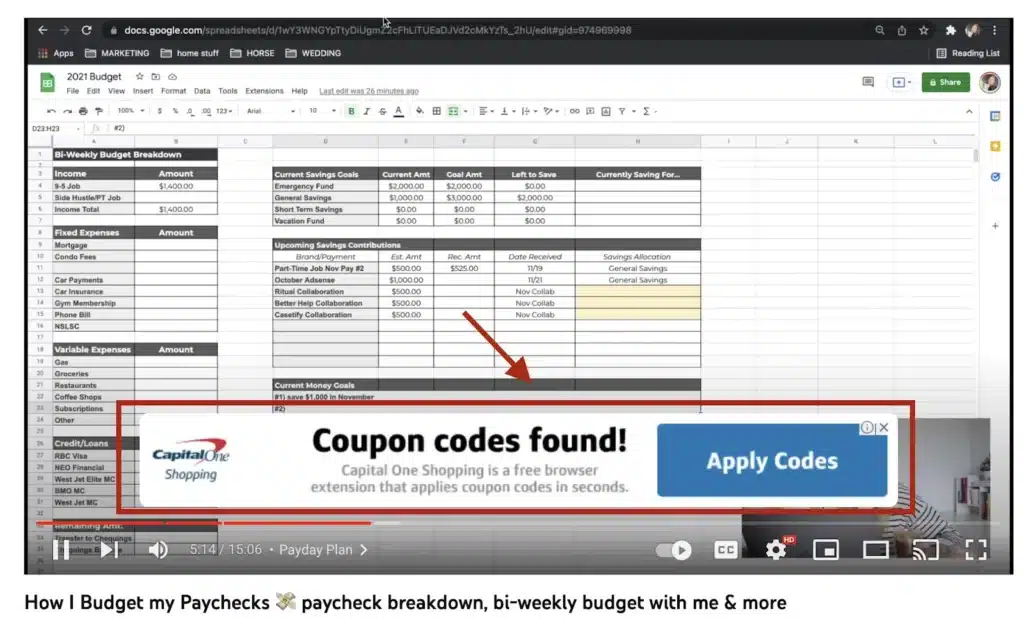
These ad formats can be an important part of your strategy. Overlay ads in particular can help you reach users to remind them that you’re there with a great offer, making them a solid choice for retargeting campaigns.
How To Get Started
To get started with YouTube Ads for SaaS brands, we’re going to strongly recommend you come in with:
- An existing Google Ads account (if you don’t have one, you can create one here)
- An existing branded YouTube channel with videos uploaded
- If you want to keep ads off your public channel, you can always upload them and set them to “unlisted” so that they’re only shown to users with a link… or those who see the ad
- A strategy in mind; who do you want to reach, and what targeting do you plan on using?
- Videos ready to go that are well within the 6, 15, or 20-second marks
Creating YouTube Ads for SaaS Brands
Since you may not be familiar with the YouTube Ad system, we’ll show you how easy it is to get set up.
First, you’ll choose an objective. They’re all straightforward, and you can choose from any of the options except for app promotion. Remember to choose the objective that you want to focus on with this specific campaign because Google will optimize for that action.
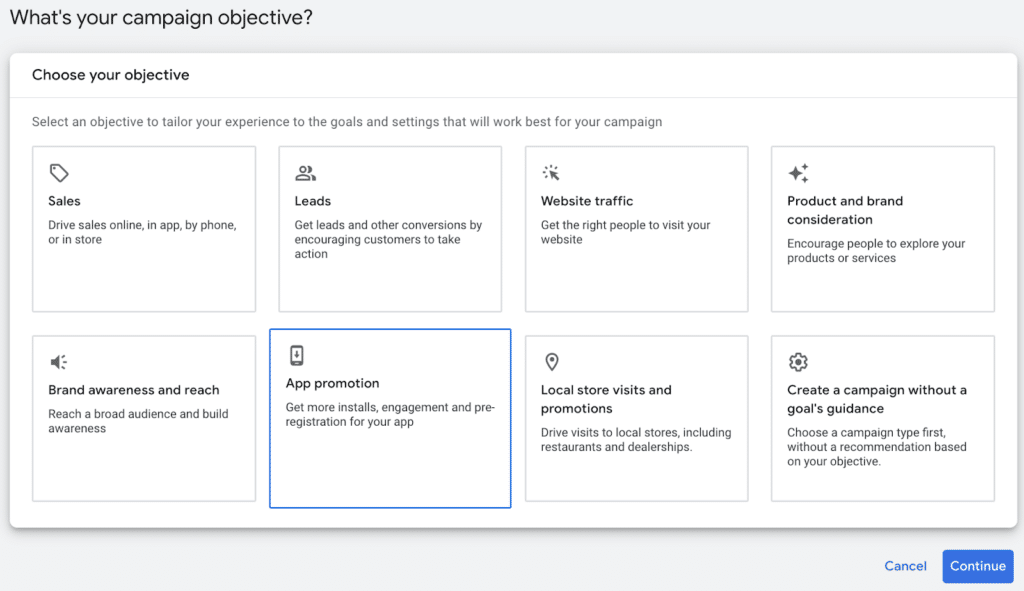
You’ll then select “Video” as the campaign type so you can run YouTube Ads. You can, however, also choose Performance Max or Discovery campaigns, which also allow you to run YouTube Ads, though they aren’t necessarily the entire focus.

You’ll name your campaign (make it something easy to identify later!), the country where your audience lives, and the languages they speak.

Choose your bid strategy (Google will automatically recommend one, which is normally a safe bet, especially when you’re getting started), and then set your daily budget or your total campaign budget.
Underneath this, you can enable or disable different networks where your ad will be shown, which include YouTube search, YouTube videos, and video partners on the Display Network; we recommend leaving them all enabled unless you have a specific reason not to.
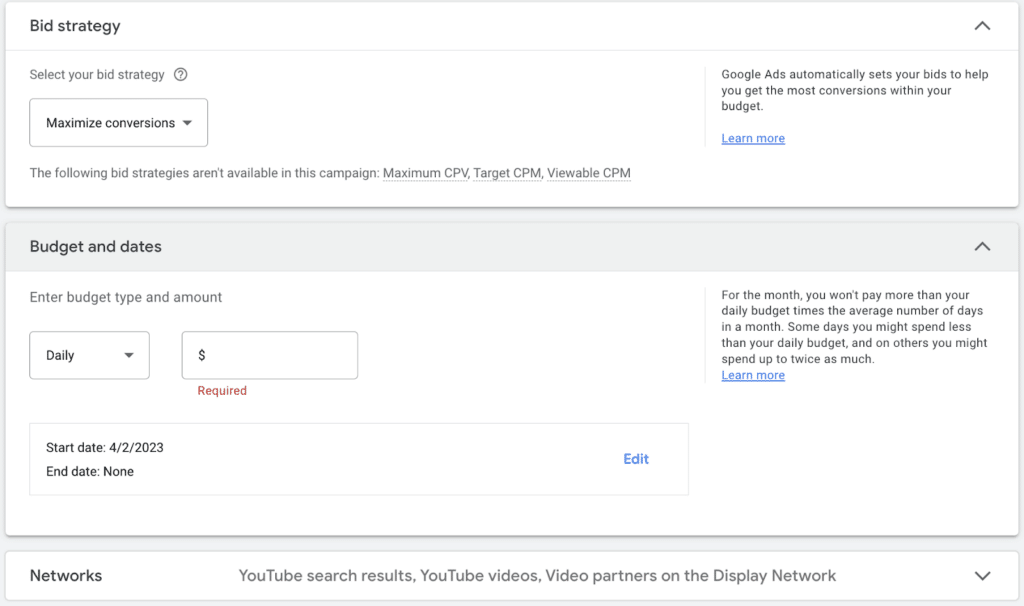
You’ll then be able to leave optimized targeting enabled (which we recommend, as it uses Google’s machine learning) and audience targeting criteria. We’ll go over audience targeting a bit more later on in this post.

Finally, upload the links to the YouTube videos that you want to use as your ad campaigns. This is perhaps the easiest ad creation setup ever since you just need to link to a video instead of setting up images, copy, and more like other platforms.
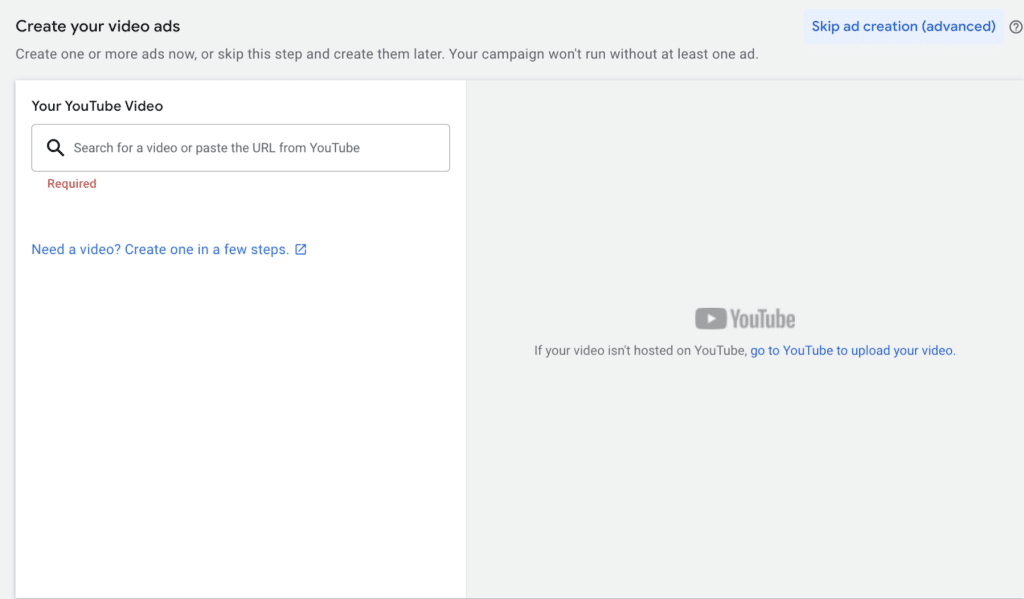
Once you’re done, you can submit your ads for review.
8 Strategies for Successful YouTube Ads for SaaS Brands
You’ve got the basics of creating YouTube Ads for SaaS brands, but now let’s talk about how to run them successfully. You can generate leads, build brand awareness, and drive sales with YouTube Ads, so let’s look at eight strategies that will help you get the job done.
1. Find a Hook That Works
When writing this guide, we asked Austin LeClear (Co-Founder of the Google Ad agency GrowMyAds) what his number one tip was for creating killer YouTube Ads, and this was his answer:
“The most important part of cracking YouTube ads is finding a Hook that works. I see too many companies spend thousands of dollars on some expensive corporate branded video that has zero hooks or impact.
“You have 5 seconds to hook your audience, hit them hard. Test, test, test. I’d spend more time testing hooks than anything else. Get the Hook + right audience targeting and you’ll have created a money printer for your business.”
For a quick recap: A hook is the attention-grabber that captures your audience in the first few seconds. It can be:
- An acknowledgment of a core pain point
- A fascinating statistic
- A lightning-fast story
- Asking a question
- Stating a problem and immediately saying you have the solution
This video, for example, has a great hook— what if you knew exactly where each dollar was going each time you got a paycheck? That’s enough for many people to pay attention, especially if they need a budgeting tool.
2. Test Different Video Lengths
Testing is always a favorite when we’re talking about any marketing campaign, especially a paid advertising campaign. And yup, video lengths should be included in that.
Test bumper ads, non-skippable ads, and skippable ads of varying formats. You might find that 15-second ads have higher view completion rates when skippable than 20-second non-skippable ads. You might also find that bumper ads are too short to get your point across for brand awareness and that they’re more effective for retargeting.
Every brand and every audience is different. Test to see what works for you.
3. Feature Video of the Product Interface
When it comes to YouTube Ads for SaaS brands, you need to remember what users need to see when making a decision… and in many cases, that’s the interface.
The user interface is a huge part of the SaaS buying process, and it can directly impact whether a user signs up or converts. Including a video of the product interface and showing how different key features work is a great choice.
This video isn’t a YouTube Ad, but it does a good job of showcasing how to incorporate product interface video clips alongside a stylized and branded explainer video:
4. Use Storytelling
Perhaps no medium lends itself better to storytelling than video, so take advantage of that. A great story is a great hook, and it can help make your SaaS tool feel more personal, valuable, and needed.
Stories need to be brief to be YouTube Ads, but there’s a lot you can do in 20 seconds or less, and branded stories are both powerful and memorable. They’re a great choice for brand awareness campaigns because users will remember that story even if they don’t know much about your product yet.
While this video is too long to be a YouTube Ad, it could be condensed to create a great SaaS YouTube Ad driven by storytelling:
5. Create Unique Videos for Segmented Audiences
We’re willing to bet that you don’t have just a single audience segment and only those users utilize your tool for a specific reason and a specific way.
Most SaaS tools (really, almost all of them) have at least a few audience segments.
You’ve got some clients who use a site like Shopify because it’s trusted, for example. Others use it because it makes eCommerce site management easy. And you’ve got some huge brands like Gap that use it because of the amazing scalability. Those are all different types of users and different use cases.
Create videos that appeal to your different audience segments. Google has some great optimized targeting abilities, and combining those with a few helpful audiences targeting options can go a long way. This brings us to our next strategic tip for SaaS YouTube Ads…
6. Be Strategic About Targeting
Targeting is going to account for a lot here. When you’re talking about video ads, you’ll be utilizing the audience targeting screen you see below:
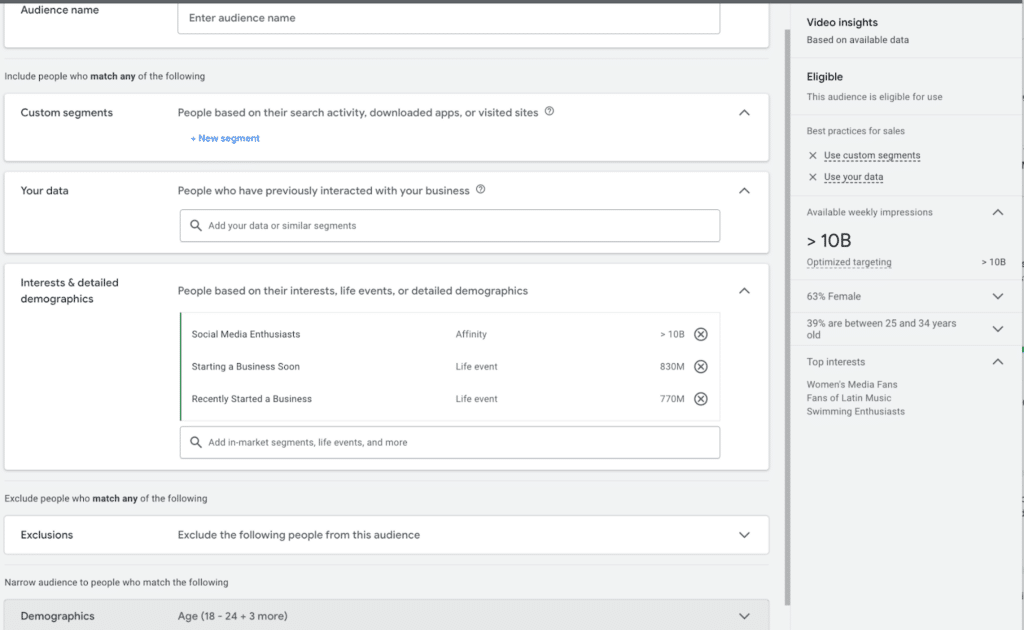
This is part of the ad set-up process, and it allows you to add the following options together as you see fit:
- Demographic targeting, like age or gender
- Interest and detailed demographics, like “recently started a business” or “social media enthusiast”
- Retargeting data to reach users who have already had some interaction with you
- Exclusionary targeting to keep certain people from seeing the ad campaign
The remarketing and the interest and detailed demographics features are going to be big here. Take some time to browse through different options available under the interests category, and then search for specific traits you know your audience has, like “mobile users” or “SEO and SEM.”
7. Consider Targeting Your Competition’s Keywords
We’ve focused most heavily on in-stream ads in this post, but an outstanding strategy to consider is to create in-feed ads that target your competitor’s keywords.
If you search for “Salesforce” in the YouTube search engine, you may see an ad for monday.com, which is a direct competitor. This is a genius move; it’s the very first search result, and if people are considering Salesforce as a solution, they may be open to other alternatives.
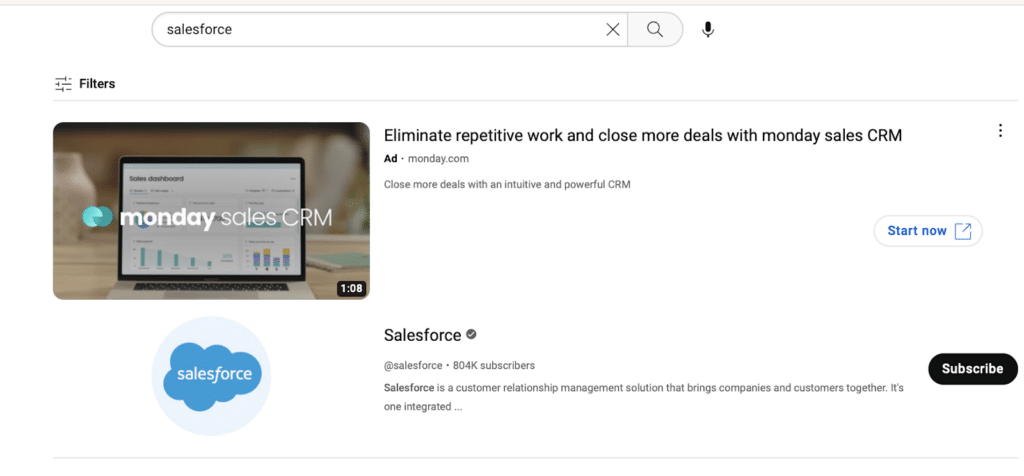
Make sure that your videos here do an exemplary job explaining why you’re a suitable solution for the specific competitor you’re targeting, especially if you have multiple use cases.
8. Use Content Exclusion Features As Needed
Google offers something called “content suitability” controls, which are essentially brand safety controls. It’s an account-level setting that you can adjust to determine what types of videos you want your ads to show up alongside.
To access these controls, go to your “Tools and settings” from the Google dashboard, and then find “Content suitability” under “Setup.”
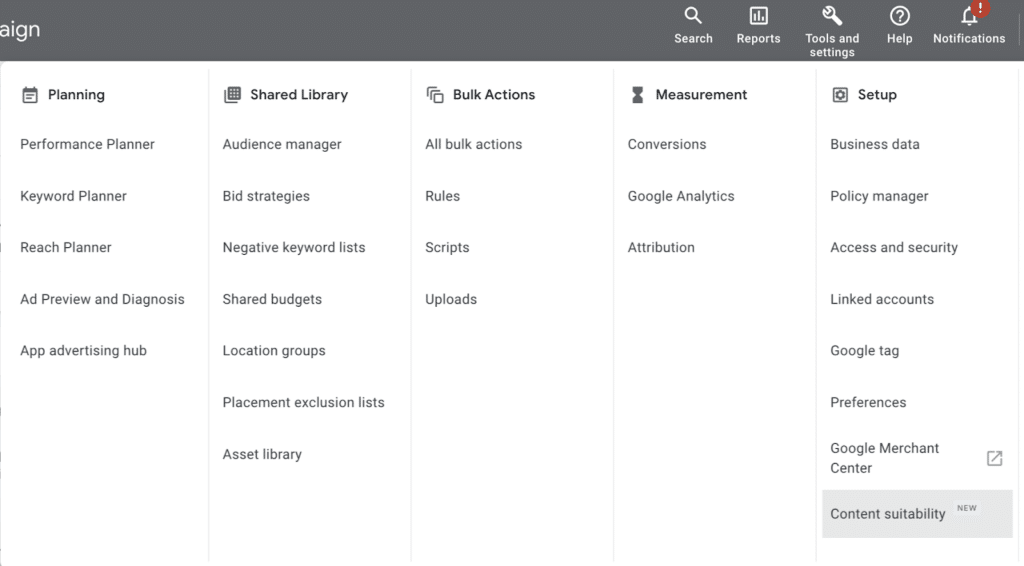
This will allow you to select the type of inventory you want to select when it comes to showing your ads. The recommended is the standard inventory, which means your ads will show up on “content that’s appropriate for most brands.” The most restricted is the “limited” inventory, which prevents your ads from showing up alongside any videos that have even moderate profanity or moderate sexually suggestive content.
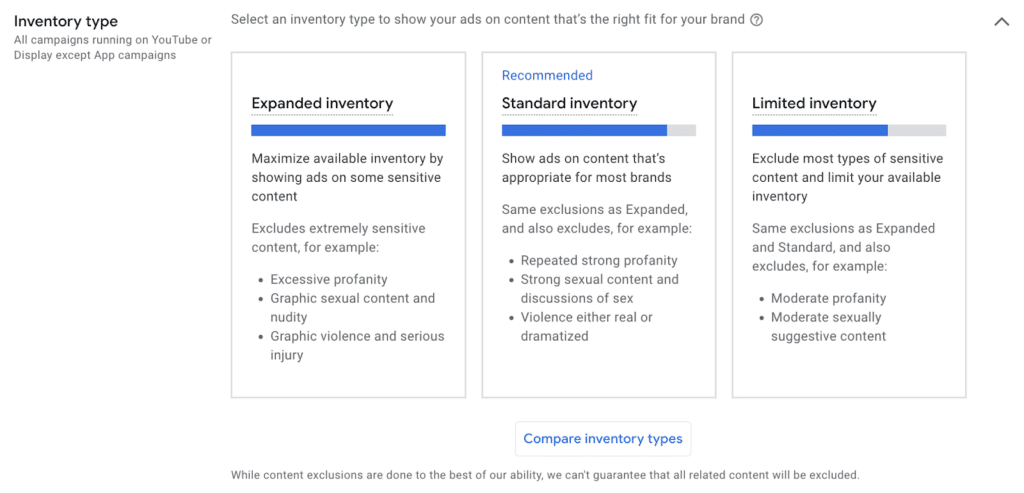
You can see a good breakdown here (though the full list can be accessed through the Tools and settings feature!):

There’s no wrong answer here, so choose whatever you feel best aligns with your brand.
Final Thoughts
YouTube Ads for SaaS brands can be an exceptional part of your marketing mix and your advertising strategy, as long as you understand how to target the right people and how it fits into your marketing sales funnel. It may take a little testing, but with a good strategy, solid video, and a great hook, you’ll be off to a great start.
Want to learn more about excelling with SaaS marketing? Check out our best SaaS marketing examples gallery!


